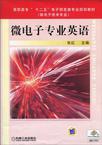微电子专业英语
2010-8
机械工业出版社
张红 编
143
无
当今世界处于国际化、信息化时代,科技的不断发展和国际化趋势对科技人才英语的要求越来越高。开设专业英语的目的是为了强化和巩固基础英语并进行实践应用,从而掌握科技英语技能,方便国际交流,了解国内外最前沿的专业动态。 本课程的教学对象是微电子专业的高职高专学生。入学时,由于经过中学6年的英语学习,学生应已经掌握了基本的英语语法知识和一定数量的单词,并在听、说、读、写等方面受过初步的训练。在本课程之前,由于已上过“半导体器件物理基础”、“微电子概论”、“微电子工艺”、“集成电路设计”等相关课程,学生应该已经具备一定的专业知识并能较好地进行微电子专业英语的学习。本书共分为六章。第一章为History,第二章为chip,第三章为Technology,第四章为Encapulation&Testing,第五章为Equipment,第六章为Business writing。建议本课程的授课时数为32-64学时。 本书由常州信息职业技术学院的张红老师担任主编,负责第二章和第六章内容的编写及本书所有章节的安排和统稿;无锡商业职业技术学院的吴建军老师担任副主编,负责第四章内容的编写;此外,淮安信息职业技术学院的张楼英老师也担任副主编,与淮安信息职业技术学院的赵安邦老师负责第三章内容的编写;大连职业技术学院的王秋菊老师负责第一章内容的编写;南京信息职业技术学院的赵丽芳老师负责第五章第4单元内容的编写;重庆信息职业技术学院的刘新老师负责第五章第1-3单元内容的编写。本书由中电集团第24研究所的刘涛工程师任主审。大连职业技术学院的孟祥忠老师和北京邮电大学的张官兴同学为本书搜集了很多的资料,给予了很多帮助。在此,对于所有帮助过我们的老师和同学表示最诚挚的感谢! 由于受到时间和水平的限制,本书难免存在许多不足之处,敬请尊敬的专家、老师、同学和读者们批评指正。
本书的教学对象是微电子专业的高职高专学生。先导课程有“半导体器件‘物理基础”、“微电子概论”、“微电子工艺”、“集成电路设计”,经过这些课程的学习,学生应该已经具备一定的专业知识并能较好地进行微电子专业英语的学习。 本书共分为六章。第一章为History,第二章为Chip,第三章为Technology,第四章为Encapsulation&Testing,第五章为Equipment,第六章为Business Writing。最后还介绍了简历及论文摘要的撰写方法,让学生对本行业的专业英语有个全面的认识。建议本课程的授课时数为32~64学时。 其他专业的读者也可通过对本书的学习对微电子专业有所了解,既学习了英语,又开阔了知识面。 为方便教学,本书备有免费电子课件,凡选用本书作为授课教材的学校和教师均可来电索取,咨询电话:010—88379375。
前言Chapter 1 HistoryChapter 2 ChipChapter 3 TechnologyChapter 4 Encapsulation&TestingChapter 5 EquipmentChapter 6 Business WritingAppendix 部分参考译文及练习答案第一章 历史 第一单元 A.课文 仙童公司的第一只晶体管 B.阅读 第二单元 A.课文 逻辑电路的历史 B.阅读 第三单元 A.课文 Wanlass的收获 B.阅读第二章 芯片 第一单元 A.课文 LM741运算放大器 B.阅读 第二单元 A.课文 DM74LSl38·DM74LSl39译码器/多路输出选择器 B.阅读 第三单元 A.课文 低功耗、8通道、串行10位ADC 伪差分输入 采样/保持 B.阅读第三章 工艺 第一单元 A.课文 半导体制造过程中的离子注入工艺 蒙特卡罗法模拟离子注入 B.阅读 第二单元 A.课文 热氧化 B.阅读第四章 封装与测试 第一单元 A.课文 组装与封装 B.阅读 第二单元 A.课文 先进的封装因素 B.阅读第五章 设备 第一单元 A.课文 半导体晶圆制造设备 外延反应设备 氧化系统 扩散系统 离子注入系统 物理气相淀积系统 化学气相淀积系统 光刻设备 刻蚀设备 B.阅读 第二单元 A.课文 半导体封装设备 B.阅读 第三单元 A.课文 化学机械平坦化设备 B.阅读 第四单元 A.课文 离子注入机的基本结构 离子注入机类型 B.阅读第六章 应用文 第一单元 A.课文 论文摘要 B.阅读 第二单元 A.课文 如何撰写简历及自荐信 B.阅读参考文献
The Development of Fairchild By the end of 1960, Fairchild Semiconductor employed 1550 employees. Thanks to Ed Bald-win, Fairchild had a state-of-the-art new facility completed in August 1959 and expanded in 1960,with total area of 108,000 sq. ft. at 545 Whisman Road in Mountain View. The facility in San Rafael had about 55,000 sq. ft. and the facility in Palo Alto had 56-,O00sq. Ft. The major problemwas to find a qualified labor force. At that time Fairchild Semiconductor was hiring almost indiscriminately. The company was growing significantly, and as always, the growth brings problems. Transfer from the development facility in Palo Alto to manufacturing facilities was slow and difficult, and management needed to solve many problems which may be tougher than technical ones. For example,in December 1960, Eugene Kleiner asked Gordon Moore to solve a problem when the staff in Palo Altowas accusing people from Mountain View of taking Palo Altos supplies of paper and pencils. When Charles E. Sporck arrived as a new Production Manager in October 1959, he noticed that Fairchild had "no structured manufacturing organization". The Fairchild Research and Developmentwas in the same situation. At the end of 1959, Gordon Moore ran the Chemistry Section with Bernard Rabinovitch (surface characterization), Worden Waring (packaging), Paul Ignacz (electro-chemical) and Bernard Yurash (analytical services). In the Physics Section were C.T. Sah, D.A.Tremere ( tunnel diode), B.D. James and Fred Schulenberger ( Aluminum Alloying), Otto Leisti-ko, A. P. Halle ( vacuum deposition of SiO ( not SiO2 ! ), TomBurke and Phillip S. Flint ( mesatransistor), O.V. Hatcher (low capacitance diode), C.A. Lasch, E. W.Okeefe (diffusion aridfurnace operation), Sheldon Roberts and L. Lynn (material research). The members of the transistor Development Sections were M. Weissenstern, S. Levine, Garry Parker, R. Brown, P.James, R. Craig, Dave Allison and B. Bently. Victor H. Grinich was running the Engineering Department and the Device and Reliability Evaluation Department. After Ed Baldwins defection, BobNoyce became the General Manager and Vice-President. Julius Blank was running Fairchild Fgcili-ty, and Eugene Kleiner was running business operations in the Mountain View Facility. Jay Last and Jean Hoerni were in the companys shadow. Jay was working on the parametric diode and integratedcircuits and Jean was preoccupied with production of planar devices in Mountain View.

无